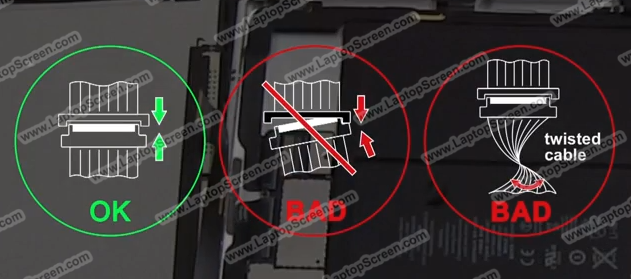With the advent of newer technologies and smaller components, now it is more important than ever to be mindful of your “technician bed-side manner”, whether you are a one time repairer or a weathered pro.
In our experience, the LCD data cable can be a source of additional headaches, which are easily escaped by following proper reconnection techniques. Although this topic spans all connectors one may disconnect on any electronics device, the “biggest offenders” are by far the new style LED 40 pin and smaller type data connectors. Most newer LED screens use a standard 40 pin connector and some screens come with even smaller proprietary sockets all of which are tiny, fragile and sometimes confusing.
The main condition to be aware of when dealing with LED data connectors is that nowadays most of them supply power to the backlight directly through the data connector. Pins 37-40 of a standard 40 pin connector are typically reserved to supply 32 volts at 1.5 amps of power to get the array of Light Emitting Diodes to light up the screen. That is a substantial amount of power which will cause irreversible damage to components that are not meant for that load, of which there are plenty in a mobile computer.
We always recommend to disconnect the AC power and to remove the battery when conducting a screen replacement. However disconnecting power sources is not always possible due to manufacturer’s limitations. And even when all sources of power are disengaged, the capacitors in the power supply circuits can still hold residual power, which in unfortunate circumstances can get offloaded onto an unsuspecting low voltage circuit, causing it to give up in a puff of blue smoke.
So, whenever disconnecting or reconnecting any connection in a laptop, especially the LCD data cable, make sure it is aligned straight with it’s socket. Slanting the connector in either direction can cause power pins to make contact with data pins, and only a tenth of a second later a fuse or the entire circuit can burn out. Replacing individual fuses for laptop’s intricate circuit is possible, while replacing an individual circuit on a motherboard is not; do not reply on fuses, use caution and patience instead.
Likewise, connecting the data cable in reverse will definitely make power pins align with contacts that were never meant for such input, and as a result may cause damage to the fuse or irreversible damage to the circuitry.
To summarize: in order to avoid damage during your repair, be patient, cautious as well be prepared to examine, study, investigate, before you break, rip or disconnect. Be super careful when touching cables and connectors; and before repair seek instructions in form of videos or manufacturer manuals, and obviously reading our articles and posts is a good step also!
Copyright (©) LaptopScreen.com

